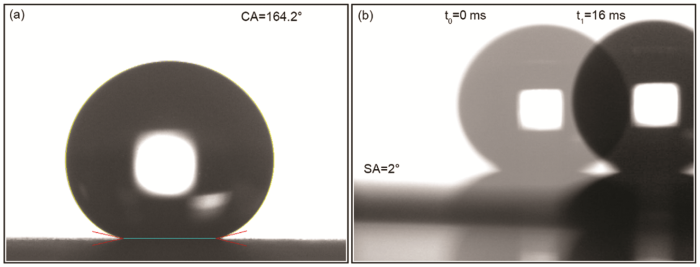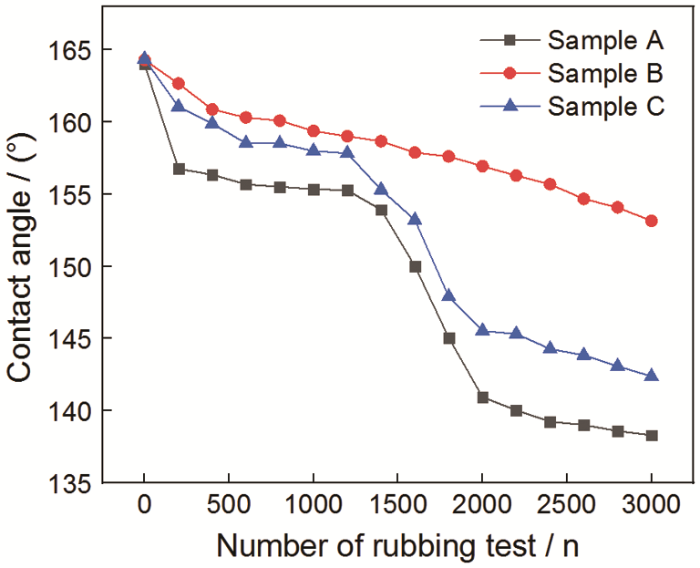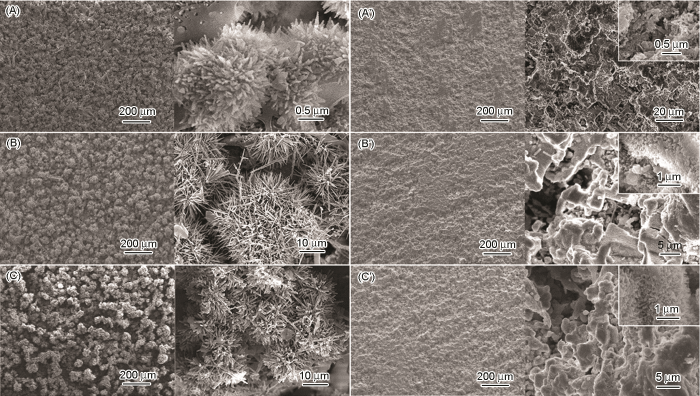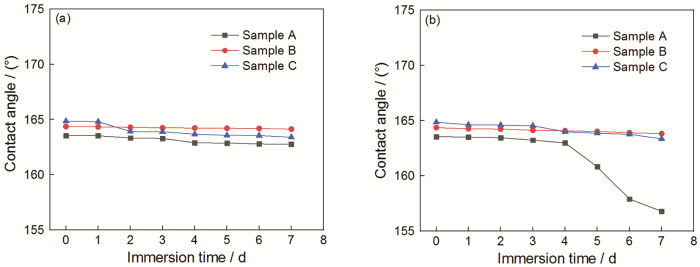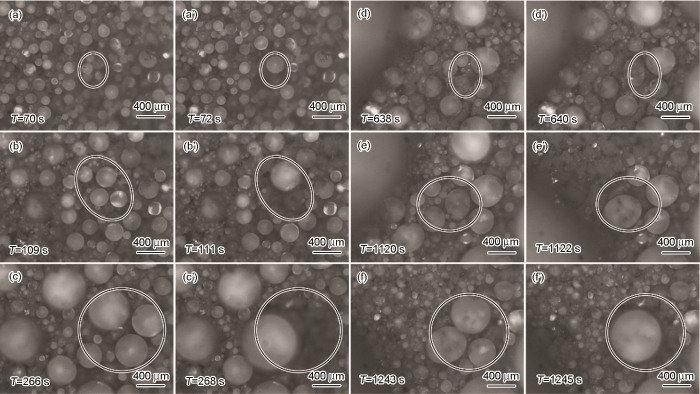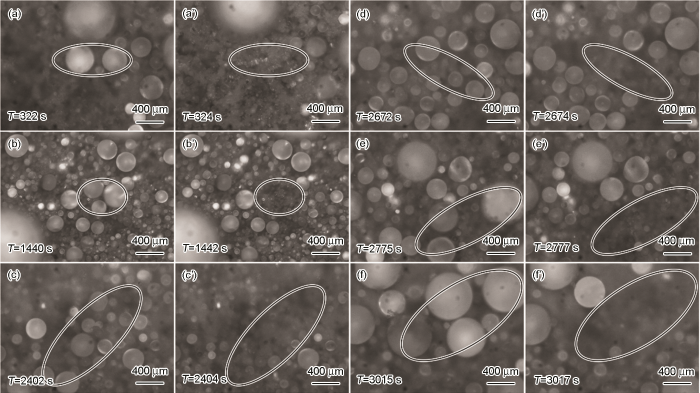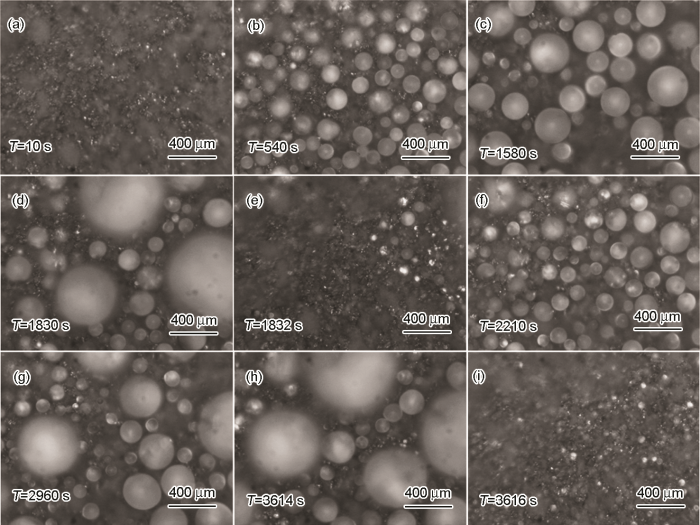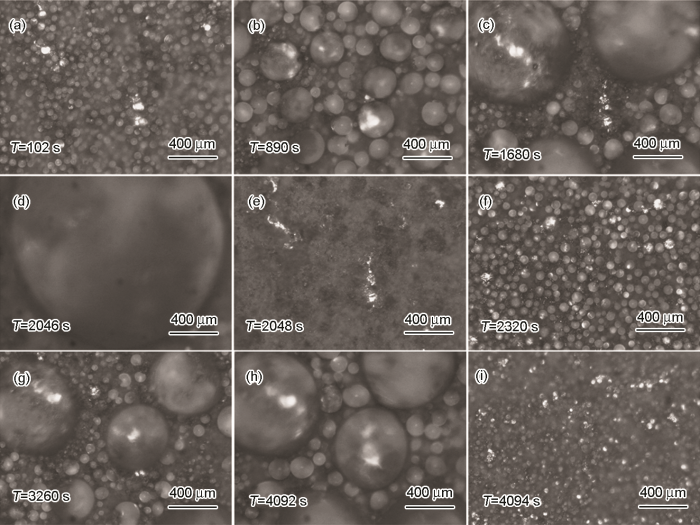发现“荷叶效应”以来,具有优异斥水特性的超疏水材料在自清洁、油水分离、防覆冰、耐腐蚀等领域的应用引起了广泛的关注[1,2,3,4,5,6,7,8]。但是,研究结果表明,大部分超疏水材料只是在湿度不太高的条件下才具有动态疏水性。即使是荷叶这一典型的天然超疏水材料,也在冷凝条件下失去疏水性[9]。其原因是,冷凝成核具有随机性,冷凝液滴在长大过程中若不能及时从粗糙结构凹槽中“冒出”并形成Cassie态接触,就会停留在Wenzel态表现为滚动角增加而失去疏水性 [9,10]。2007年Chen等[11]首次报道了一种能抗冷凝液滴浸润的仿荷叶材料,并观察到持续的滴状冷凝过程。2009年同一研究组的Boreyko等[12]深入报道,超疏水材料表面冷凝液滴合并释放出的多余表面能能促使合并后的液滴以1m/s的速度跳离冷凝面。至此,利用超疏水材料表面冷凝液滴合并自弹跳这一奇特机制,成为提高滴状冷凝传热效率、防结冰结霜等应用的重要切入点。
为了实现冷凝液滴持续自弹跳,必须确保液滴合并前处于Cassie态[13,14,15,16,17,18]。冯杰等[15,16]指出,实现冷凝液滴自弹跳的关键是材料表面的粗糙度小于某一临界值,纳米结构足够陡峭,能提供足够高的Laplace压力使冷凝液滴从Wenzel态迅速转变为Cassie态。Shin等[17]应用等离子体增强化学气相沉积技术在无纺布表面构筑了不同“高宽比”的纳米结构,发现冷凝液滴在具有较大“高宽比”的纳米结构表面容易滚落,而当纳米结构“高宽比”较小时冷凝液滴易粘附于表面。Ko等[18]也发现,在碳纳米纤维超疏水表面,当纳米结构的“高宽比”较大时能够实现滴状冷凝,水滴也容易滚落。由此可见,纳米棒、纳米锥、纳米针等结构更有利于维持冷凝状态下的超疏水性。而这一结构要求,势必降低耐冷凝超疏水材料的机械稳定性。同时,超疏水材料通常不能在强酸强碱等极端的环境中长期使用。因此,制备机械稳定性好、耐酸耐碱的超疏水材料对于拓展其在冷凝环境下的使用具有重要的意义[19,20,21]。本文制备铝基耐磨超疏水材料,分析其摩擦试验前后的冷凝运动趋势、冷凝液滴合并自弹跳现象以及冷凝循环周期。
1 实验方法
1.1 样品的制备
用水热法制备铝基超疏水材料[21,22,23,24],其流程为:(1) 将裁剪成合适大小的铝片依次用去离子水、酒精和0.1 mol/L硫酸丙酮混合液超声清洗,再经1 mol/L HCl刻蚀25 min,然后洗净烘干;(2)水热反应种子层:将0.1 mol/L氢氧化钠和0.1 mol/L醋酸锌以2:1的体积比混合,在60℃恒温搅拌5 h;(3)水热反应液:配制0.05 mol/L醋酸锌溶液,在其中逐滴加入氨水,充分搅拌直至反应液二次完全澄清;(4)涂覆种子层:控制匀胶机转速3000 r/min,匀胶后置于200℃烘箱烘干1 h,分无种子层和3层种子层两种情况;(5)水热反应:温度为145℃,时间设定为1 h或3 h,自然冷却;(6)低表面能化:将水热样品洗净后在200℃干燥2 h,然后浸泡在0.05 mol/L的硬脂酸乙醇溶液中10 min,用酒精、去离子水冲洗干净后放入80℃烘箱中烘干20 min。
1.2 性能的表征
分别用FTA1000接触角测量仪和角位移测定接触角、滚动角,液滴大小约为5 μL,在每个样品上随机选取五个位置取其测量值的平均值;用场发射扫描电子显微镜(JSM-7610FPlus)观察样品的表面,以分析摩擦对样品表面形貌的影响;将样品分别浸入pH=4的盐酸和pH=12的氢氧化钠溶液中,用接触角随时间的变化表征材料的耐酸碱腐蚀能力;用耐磨擦试验机(A220-339)测试超疏水材料的机械稳定性。自制冷凝试验平台,包括温度控制模块、图像采集模块两部分。测试条件为:环境温度25℃,环境湿度55%RH,冷凝平台温度1℃,冷凝面水平放置。本文重点研究高湿度环境下冷凝液滴动态的疏水性能,不分析冷凝液滴合并自弹跳频率、半径、跳离速度,每2 s自动拍摄一幅冷凝照片,照片分辨率为2592×1944,拍摄时长超1 h。镜头选用20X、10X、4X光学显微镜头。
2 实验结果和分析
2.1 水热反应参数对接触角和滚动角的影响
表1 水热反应主要参数对接触角和滚动角的影响
Table 1
| Sample | A | B | C |
|---|---|---|---|
| Number/n | 0 | 3 | 3 |
| Time/h | 3 | 1 | 3 |
| (Contact angle) Average/(°) | 163.6 | 164.2 | 164.4 |
| (Sliding angle) Average/(°) | 2.5 | 1.8 | 1.8 |
图1
图1
样品B表面水滴的静态接触角和滚动角
Fig.1
Contact angle (a) and sliding angle (b) of sample B
2.2 耐磨性能
目前测试超疏水材料机械稳定性,还没有统一的标准[25]。本文使用耐磨擦试验机测试超疏水材料的机械稳定性,用接触角随摩擦次数的变化表征样品耐磨性能。考虑到摩擦后样品表面均匀性对平均接触角的影响,摩擦试验的磨头选用棉布,在11 KPa压力条件下,摩擦一个来回计为一次,一个循环距离为6 cm。如图2所示,经1500次摩擦后3个样品的接触角均高于150°。增加摩擦次数后样品A(无种子层,水热反应3 h)和样品C(3层种子层,水热反应3 h)的接触角急剧下降,不再具有超疏水特性,其原因可能是表面结构遭受严重破坏。摩擦次数超过2000次以后,接触角随摩擦次数的增加而下降的趋势有所缓解。但是,样品B(3层种子层,水热反应1 h)始终具有非常好的耐磨性能,3000次循环摩擦后接触角仍大于155°,滚动角小于10°。这表明,本文制备的铝基超疏水材料具有良好的机械稳定性,尤其是样品B。
图2
图2
样品接触角随摩擦循环次数的变化
Fig.2
Contact angle of the samples varies with number of rubbing test
2.3 摩擦前后样品的形貌
如图3所示,摩擦前3个样品均具有微纳米复合结构。将无种子层的样品A与均为3层种子层的样品B和样品C对比,表面清晰可见的ZnO纳米棒充分说明种子层在水热生长过程中的辅助作用。相较而言,水热反应1 h的样品B表面纳米棒略显纤细,而水热反应3 h的样品C表面纳米棒则较为粗壮。经过2000次循环摩擦测试后样品表面的磨损痕迹都很明显,表面变得略显平整,微米结构丢失。但是,在高放大倍数下仍能观察到纳米棒,只是纳米棒长度有削减。其原因可能是,反复摩擦使纳米棒折断,部分磨损物填充了较大的孔隙。在微纳米复合结构中,ZnO纳米棒才是保持样品超疏水性能的主要原因,即使表面微米结构遭破坏,样品仍能保有超疏水性[26]。后续的冷凝实验结果进一步证实,本文的微米结构除了能提高超疏水材料的耐磨性,还能促使冷凝液滴长大合并过程中从凹槽内“冒出”而最终悬浮于样品表面。
图3
图3
样品摩擦前和2000次摩擦后表面形貌的对比
Fig.3
Comparison of surface morphology of samples before and after 2000 rubbing test: sample A (no seed layer, hydrothermal reaction 3 h) before (A) and after rubbing (A'); sample B (3 layers of seed layer, hydrothermal reaction 1 h) before (B) and after rubbing (B'); sample C (3 layers of seed layer, hydrothermal reaction 3 h) before (C) and after rubbing (C')
2.4 耐酸碱性能
图4
图4
样品接触角随浸渍时间的变化
Fig.4
Contact angle of the sample changes with the number of immersion days (a) acid resistance test and (b) alkali resistance test
2.5 冷凝行为
鉴于3层种子层水热反应1 h的样品B具有最好的机械稳定性和耐酸碱腐蚀能力,本文重点分析摩擦试验前后样品B表面的水滴动态冷凝行为。由对冷凝实验图片的分析可知,在冷凝初期在粗糙结构表面会随机生成冷凝液滴。有意思的是,在冷凝过程中冷凝液滴并未优先填满凹槽最终形成Wenzel态接触而使样品失去疏水性。如图5a和a'、b和b'及c和c'所示,在不断的长大合并过程中凹槽中的小液滴最终合并成大液滴并以Cassie态浮于粗糙结构表面。同时,如图5d和d'、e和e'及f和f'所示,冷凝液滴的生长过程受到周围微米级粗糙结构的影响,部分水滴可能严重变形,但是在后续的长大合并过程中也以球型浮于粗糙结构表面[27]。伴随着冷凝液滴不断长大,除发生上述现象外,也发生多种形式的冷凝液滴合并自弹跳现象。本文每隔2 s拍摄一幅冷凝过程图片,这个时间间隔不足以准确界定冷凝液滴合并瞬间。如图6所示,对比前后间隔2 s的图片可发现多个液滴合并后留下的“空白”区域。发生合并弹跳的冷凝液滴多为半径相差不大的球状,但是实验发现凹槽中不规则冷凝液滴与周围液滴合并也发生弹跳。这说明,样品表面粘附力极低,冷凝液滴在样品表面始终保持Cassie状态,未进入凹槽结构中润湿样品。
图5
图5
样品B摩擦前冷凝液滴从凹槽中“冒出”
Fig.5
Condensed droplets “emerge” from the groove during condensation process on sample B before rubbing test
图6
图6
样品B摩擦前冷凝液滴的合并弹跳现象
Fig.6
Self-propelled of condensate droplets of sample B before rubbing test
此外,在冷凝实验中还发现,超疏水样品表面存在明显的冷凝液滴循环生长周期。以未摩擦超疏水样品B为例,如图7所示,在冷凝初始阶段冷凝液滴在样品表面随机成核,随着冷凝过程的持续整个画面布满清晰可见的滴状冷凝液滴,液滴尺寸大小不一。冷凝时长达到1830 s后在表面会生成个别大液滴,直径可达300~500 μm。但是,这些大液滴仍可以发生冷凝合并弹跳,完全脱离视野范围,形成较大“空白”区域,如图7e所示。以此为节点,记为一个冷凝周期。随着冷凝过程的持续这种“空白”区域会重新生长小液滴,并重复之前的合并生长过程,第二次冷凝循环过程结束于3616 s。因此可判定,摩擦前B样品的冷凝循环周期约为30 min。与之相对应,2000次摩擦后样品B的冷凝循环过程如图8所示,冷凝液滴生长过程基本一致,既有冷凝液滴从凹槽中“冒出”,也有冷凝液滴合并自弹跳,但循环周期有所延长,达34 min左右。合并自弹跳液滴尺寸也会增大,如图8d所示,整个画幅只有一个大的液滴,直径超1 mm,但仍可以在2 s后脱离视野范围。冷凝循环周期越短则冷凝液滴更新频率越高,传热效率也就越高。考虑到实验中冷凝样品是水平放置的,如此短的冷凝循环周期充分说明,这个超疏水样品表面水滴极低的粘附力和高频率的冷凝液滴合并自弹跳。
图7
图7
样品B摩擦前的冷凝循环过程
Fig.7
Condensation cycle process of sample B before rubbing test: (a~e) the first cycle of the condensation cycle; (e~f) the second cycle of the condensation cycle
图8
图8
样品B 2000次摩擦后的冷凝循环过程
Fig.8
Condensation cycle process of sample B after 2000 rubbing test: (a~e) the first cycle of the condensation cycle; (e~f) the second cycle of the condensation cycle
3 结论
(1) 机械稳定性好、耐酸耐碱的铝基超疏水材料的最优制备工艺为:铝片先经硫酸丙酮混合液和盐酸侵蚀,然后旋涂3层种子层,最后在145℃水热反应1 h。
(2) 微纳米复合结构中的微米结构能提高材料的耐磨性,还能促使冷凝液滴在长大合并过程中逐渐脱离凹槽底部,最终悬浮于微结构表面。
(3) 这种超疏水材料在冷凝条件下能保持良好的动态疏水性,冷凝液滴始终处于Cassie态,即使受挤压变形与周围液滴合并后仍能发生合并弹跳。
(4) 在冷凝面水平放置情况下摩擦前超疏水样品的冷凝循环周期约为30 min,2000次摩擦后冷凝循环周期延长至34 min,表现出良好的耐磨性。
参考文献
Anti-icing surfaces based on enhanced self-propelled jumping of condensed water microdroplets
[J].A spontaneous and controllable removal of condensed microdroplets at high supersaturation via self-propelled jumping is achieved by introducing a designed micropore array on a nanostructured superhydrophobic surface. The fabricated surface was demonstrated to delay the ice formation for 1 hour at -15 °C with a supersaturation of 6.97.
Construction of long-lasting superhydrophobic copper surface and wear resistance and self-cleaning properties
[J].
长效超疏水铜表面的构建及耐磨性和自清洁性能
[J].
Preparation and corrosion resistance of superhydrophobic cuprous oxide surface
[J].
超疏水氧化亚铜表面的制备和耐腐蚀性能
[J].
Preparation and properties of super-double-surface coating modified by fluorinated low surface energy
[J].
含氟低表面能修饰的超双疏涂层制备及其性能
[J].
Design and applications of multifunctional super-wetting materials
[J].etc. However, the inherent poor durability of the materials that are mostly developed using polymeric hydrogel, metal oxide coatings and electrostatic multilayers often challenges the application of these wettability properties in practical scenarios. Here, 'amine-reactive' polymeric multilayers of nano-complex were developed to fabricate 'internal' underwater superoleophobic/superoleophilic coatings with impeccable physical/chemical durability. This allows the super-wetting properties to exist beyond the surface of the material and remain intact even after severe physical damage including erosion of the material and continuous exposure to an artificial-marine environment for more than 80 days. Moreover, this current design allowed for independent revalidation of some key hypotheses with direct experimental demonstrations, and provided a basis to develop highly durable super-oil-wettability properties under water. It is believed that this contemporary study will make a worthwhile contribution on developing multifunctional materials for widespread practical applications by exploiting these super-oil-wetting properties.]]>
Durable and scalable icephobic surfaces: similarities and distinctions from superhydrophobic surfaces
[J].Formation, adhesion, and accumulation of ice, snow, frost, glaze, rime, or their mixtures can cause severe problems for solar panels, wind turbines, aircrafts, heat pumps, power lines, telecommunication equipment, and submarines. These problems can decrease efficiency in power generation, increase energy consumption, result in mechanical and/or electrical failure, and generate safety hazards. To address these issues, the fundamentals of interfaces between liquids and surfaces at low temperatures have been extensively studied. This has lead to development of so called "icephobic" surfaces, which possess a number of overlapping, yet distinctive, characteristics from superhydrophobic surfaces. Less attention has been given to distinguishing differences between formation and adhesion of ice, snow, glaze, rime, and frost or to developing a clear definition for icephobic, or more correctly pagophobic, surfaces. In this review, we strive to clarify these differences and distinctions, while providing a comprehensive definition of icephobicity. We classify different canonical families of icephobic (pagophobic) surfaces providing a review of those with potential for scalable and robust development.
Preparation and property of superhydrophobic phosphate-cerium composite coatings on hot-dip galvanizing carbon steel
[J].
热浸镀锌层磷酸盐-铈盐复合处理制备超疏水膜层研究
[J].在Q235钢上热浸镀锌后,经磷酸盐-铈盐-硬脂酸复合处理制备了超疏水膜层。采用接触角仪测定试样的接触角(WCA)和滚动角(WSA),研究了其疏水性;采用场发射扫描电子显微镜(FE-SEM)、能谱分析仪(EDS)、傅里叶变换红外光谱仪(FTIR)、X射线衍射仪(XRD)和X射线光电子能谱仪(XPS)研究试样的表面形貌和成分结构;采用电化学阻抗谱(EIS)和塔菲尔极化曲线(Tafel)研究试样的耐腐蚀性。结果表明,超疏水膜层通过界面空气膜层的捕获可以有效减少基体腐蚀,当硝酸铈处理时间为300 s时性能最好,在表面形成一层多孔的磷酸锌/ 铈盐微纳米复合结构;硬脂酸疏水改性后接触角达到162°,电化学阻抗增加了2个数量级,显示出良好的耐腐蚀性。
Anticorrosion performance of super-hydrophobic complex film of graphene/stearic acid on AZ91 Mg-alloy
[J].
石墨烯/硬脂酸超疏水复合膜层的防腐性能
[J].
Is the lotus leaf superhydrophobic
[J].
Microscopic observations of condensation of water on lotus leaves
[J].
Dropwise condensation on superhydrophobic surfaces with two-tier roughness
[J].Although realizing dewetting transitions of droplets spontaneously on solid textured surfaces is quite challenging, it has become a key research topic in many practical applications that require highly efficient removal of liquid. Despite intensive efforts over the past few decades, due to impalement of vapor pockets inducing strong pinning of the contact lines, how to realize the self-removal of small droplets trapped in the textures remains an urgent problem. We report an in situ spontaneous dewetting transition of condensed droplets occurring on pillared surfaces with two-tier roughness, from the valleys to the tops of the pillars, owing to the nanotexture-enhanced superhydrophobicity, as well as the topology of the micropillars. Three wetting transition modes are observed. It is found that a further decreased Laplace pressure on the top side of the individual droplets accounts for such a surprising transition and self-removal of condensed water. An explicit model is constructed, which quite effectively predicts the Laplace pressure of droplets trapped by the textures. Our model also reveals that the critical size of the droplet for transition scales as the spacing of the micropillars. These findings are expected to be crucial to a fundamental understanding, as well as a remarkable strategy to guide the fabrication, of optimum super-water-repellant surfaces.
Self-propelled dropwise condensate on superhydrophobic surfaces
[J].In conventional dropwise condensation on a hydrophobic surface, the condensate drops must be removed by external forces for continuous operation. This Letter reports continuous dropwise condensation spontaneously occurring on a superhydrophobic surface without any external forces. The spontaneous drop removal results from the surface energy released upon drop coalescence, which leads to a surprising out-of-plane jumping motion of the coalesced drops at a speed as high as 1 m/s. The jumping follows an inertial-capillary scaling and gives rise to a micrometric average diameter at steady state.
Fabrication of biomimetic polymer nanocone films with condensate microdrop self-removal func-tion
[J].
Tuning superhydrophobic nanostructures to enhance jumping-droplet condensation
[J].It was recently discovered that condensation growing on a nanostructured superhydrophobic surface can spontaneously jump off the surface, triggered by naturally occurring coalescence events. Many reports have observed that droplets must grow to a size of order 10 μm before jumping is enabled upon coalescence; however, it remains unknown how the critical jumping size relates to the topography of the underlying nanostructure. Here, we characterize the dynamic behavior of condensation growing on six different superhydrophobic nanostructures, where the topography of the nanopillars was systematically varied. The critical jumping diameter was observed to be highly dependent upon the height, diameter, and pitch of the nanopillars: tall and slender nanopillars promoted 2 μm jumping droplets, whereas short and stout nanopillars increased the critical size to over 20 μm. The topology of each surface is successfully correlated to the critical jumping diameter by constructing an energetic model that predicts how large a nucleating embryo needs to grow before it can inflate into the air with an apparent contact angle large enough for jumping. By extending our model to consider any possible surface, it is revealed that properly designed nanostructures should enable nanometric jumping droplets, which would further enhance jumping-droplet condensers for heat transfer, antifogging, and antifrosting applications.
Why condensate drops can spontaneously move away on some superhydrophobic surfaces but not on others
[J].The coalesce-induced condensate drop motion on some superhydrophobic surfaces (SHSs) has attracted increasing attention because of its wide potential applications. However, microscopic mechanism of spontaneous motion has not been discussed thoroughly. In this study, we fabricated two types of superhydrophobic copper surfaces with sisal-like nanoribbon structures and defoliation-like nanosheet structures by different wet chemical oxidation process and followed by same fluorization treatment. With lotus leaf and butterfly wing as control samples, the spontaneous motion phenomenon of condensate drops on these four kinds of SHSs was investigated by using optical microscope under ambient conditions. The results showed that among all four types of SHSs, only superhydrophobic copper surfaces with sisal-like nanoribbon structures showed obvious spontaneous motion of condensate drops, especially when the relative humidity was higher. The microscopic mechanism of spontaneous motion was discussed in relation to the states of condensate drops on different nanostructures. It shows that the instantaneous Cassie state of condensed droplets prior to coalescence plays a key role in determining whether the coalesced drop departs, whereas only SHS possessing nanostructures with small enough Wenzel roughness parameter r (at least <2.1) and nanogaps forming high enough Laplace pressure favors the formation of the instantaneous Cassie state by completing the Wenzel-Cassie transition.
Factors affecting the spontaneous motion of condensate drops on superhydrophobic copper surfaces
[J].The coalescence-induced condensate drop motion on some superhydrophobic surfaces (SHSs) has attracted increasing attention because of its potential applications in sustained dropwise condensation, water collection, anti-icing, and anticorrosion. However, an investigation of the mechanism of such self-propelled motion including the factors for designing such SHSs is still limited. In this article, we fabricated a series of superhydrophobic copper surfaces with nanoribbon structures using wet chemical oxidation followed by fluorization treatment. We then systematically studied the influence of surface roughness and the chemical properties of as-prepared surfaces on the spontaneous motion of condensate drops. We quantified the "frequency" of the condensate drop motion based on microscopic sequential images and showed that the trend of this frequency varied with the nanoribbon structure and extent of fluorination. More obvious spontaneous condensate drop motion was observed on surfaces with a higher extent of fluorization and nanostructures possessing sufficiently narrow spacing and higher perpendicularity. We attribute this enhanced drop mobility to the stable Cassie state of condensate drops in the dynamic dropwise condensation process that is determined by the nanoscale morphology and local surface energy.
Extreme water repellency of nanostructured low-surface-energy non-woven fabrics
[J].
Water condensation behavior on the surface of a network of superhydrophobic carbon fibers with high-aspect-ratio nanostructures
[J].
One-step method for fabrication of bioinspired hierarchical superhydrophobic surface with robust stability
[J].Despite the recent demands of bioinspired superhydrophobic surfaces with self-cleaning properties in various industrial applications, a low-cost fabrication method for superhydrophobic films with excellent stability has rarely been studied. Herein, we report a robust superhydrophobic organic- inorganic hybrid composites film produced via a facile one-step solution-process. As coating materials for the facile one-step fabrication of the robust superhydrophobic films, we included Al₂O₃ nanoparticles for micro/nano hierarchical dual-scale structures, alkylsilane for low surface energy, and organic cross-linkers for increasing the stability of the hybrid composite films. Based on the hydrophobicity and stability tests of the hybrid composite films, the optimized composition of the robust superhydrophobic hybrid composite films showed high water contact angles (>150°) and low sliding angles (<5°) as well as excellent mechanical and thermal stability (up to 350 °C).
Carbon fiber particle reinforced CeO2/PMMA/PVDF superhydrophobic composite coating and its wear resistance
[J].
碳纤维颗粒增强CeO2/PMMA/PVDF超疏水复合涂层及其耐磨性能
[J].
Mechanically robust superhydrophobic mesh for oil/water separation by a seed free hydrothermal method
[J].Current treatments for traumatic oral mucosal wounds include the gold standard of autologous tissue and alternative tissue-engineered grafts. While use of autografts has disadvantages of minimal availability of oral keratinized tissue, second surgery, and donor site discomfort, tissue-engineered grafts are limited by their unavailability as off-the-shelf products owing to their fabrication time of 4-8 weeks. Hence, the current work aimed to develop a potentially cost-effective, readily available device capable of enhancing native mucosal regeneration. Considering the key role of epidermal growth factor (EGF) in promoting mucosal wound regeneration and the advantages of mucoadhesive delivery systems, mucoadhesive films composed of polyvinylpyrrolidone and carboxymethylcellulose were developed to provide sustained release of EGF for a minimum of 6 h. Bioactivity of released EGF supernatants was then confirmed by its ability to promote proliferation of BALB/3T3 fibroblasts. Efficacy of the developed system was then investigated in vitro using buccal tissues (ORL 300-FT) as a potential replacement for small animal studies. Although the mucoadhesive films achieved their desired role of delivering bioactive EGF in a sustained manner, treatment with EGF, irrespective of its release from the films or solubilized in medium, caused a hyperparakeratotic response from in vitro tissues with distinguishable histological features including thickening of the spinous layer, intra- and intercellular edema, and pyknotic nuclei. These significant morphological changes were associated with no improvements in wound closure. These observations raise questions about the potential of using in vitro tissues as a wound healing model and substitute for small animal studies. The mucoadhesive delivery system developed, however, with its potential for sustained release of bioactive growth factors and small molecules, may be loaded with other desired compounds, with or without EGF, to accelerate the process of wound healing.
Preparation of superhydrophobic anti-icing zinc oxide surface by hydrothermal method
[J].
水热法制备超疏水防冰氧化锌表面
[J].
Study on hydrothermal synthesis and hydrophobic properties of stainless steel based ZnO thin films
[J]
不锈钢基ZnO薄膜的水热合成及其疏水性能研究
[J].
Preparation and durability of zinc oxide superhydrophobic films
[J].
氧化锌超疏水薄膜的制备及其耐久性
[J].
Research progress in durability of superhydrophobic surfaces
[J].
超疏水表面耐久性能的研究进展
[J].
Preparation technology and strengthening mechanism of wear-resistant superhydrophobic coating
[D].
耐磨超疏水涂层制备技术及强化机制研究
[D].
Growth rates and spontaneous navigation of condensate droplets through randomly structured textures
[J].Dropwise condensation is a phenomenon of common occurrence in everyday life, the understanding and controlling of which is of great interest to applications ranging from technology to nature. Scalable superhydrophobic textures on metals are of direct relevance in improving phase change heat transport in realistic industrial applications. Here we reveal important facets of individual droplet growth rate and droplet departure during dropwise condensation on randomly structured hierarchical superhydrophobic aluminum textures, that is, surfaces with a microstructure consisting of irregular re-entrant microcavities and an overlaying nanostructure. We demonstrate that precoalescence droplet growth on such a surface can span a broad range of rates even when the condensation conditions are held constant. The fastest growth rates are observed to be more than 4 times faster as compared to the slowest growing droplets. We show that this variation in droplet growth on the hierarchical texture is primarily controlled by droplet growth dynamics on the nanostructure overlaying the microstructure and is caused by condensation-induced localized wetting nonuniformity on the nanostructure. We also show that the droplets nucleating and growing within the microcavities are able to spontaneously navigate the irregular microcavity geometry, climb the microtexture, and finally depart from the surface by coalescence-induced jumping. This self-navigation is realized by a synergistic combination of self-orienting Laplace pressure gradients induced within the droplet as it dislodges itself and moves through the texture, as well as multidroplet coalescence.




